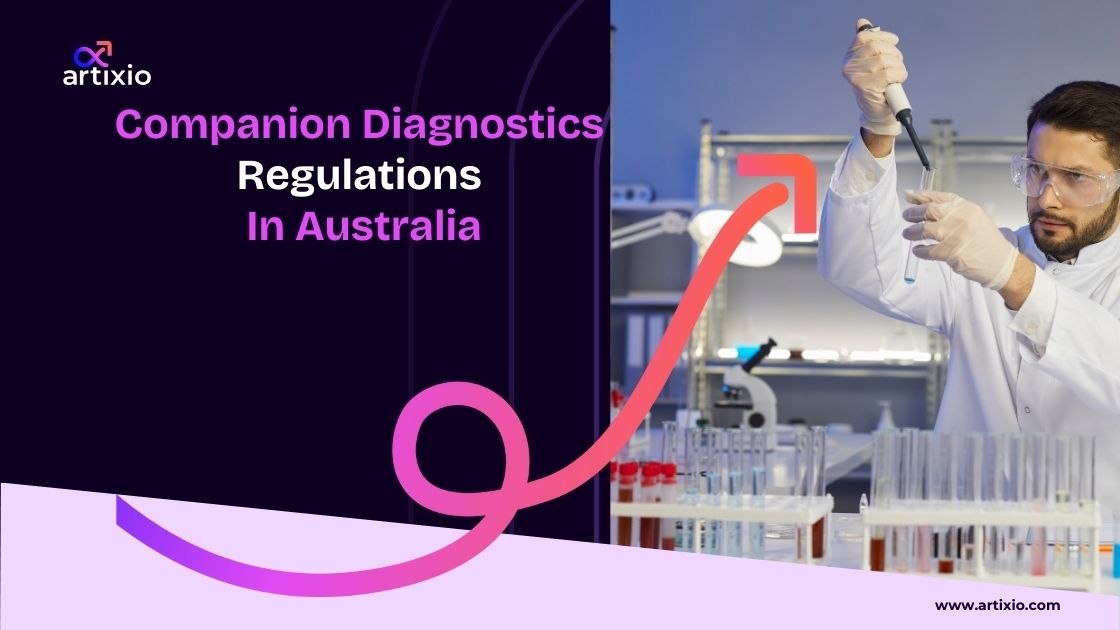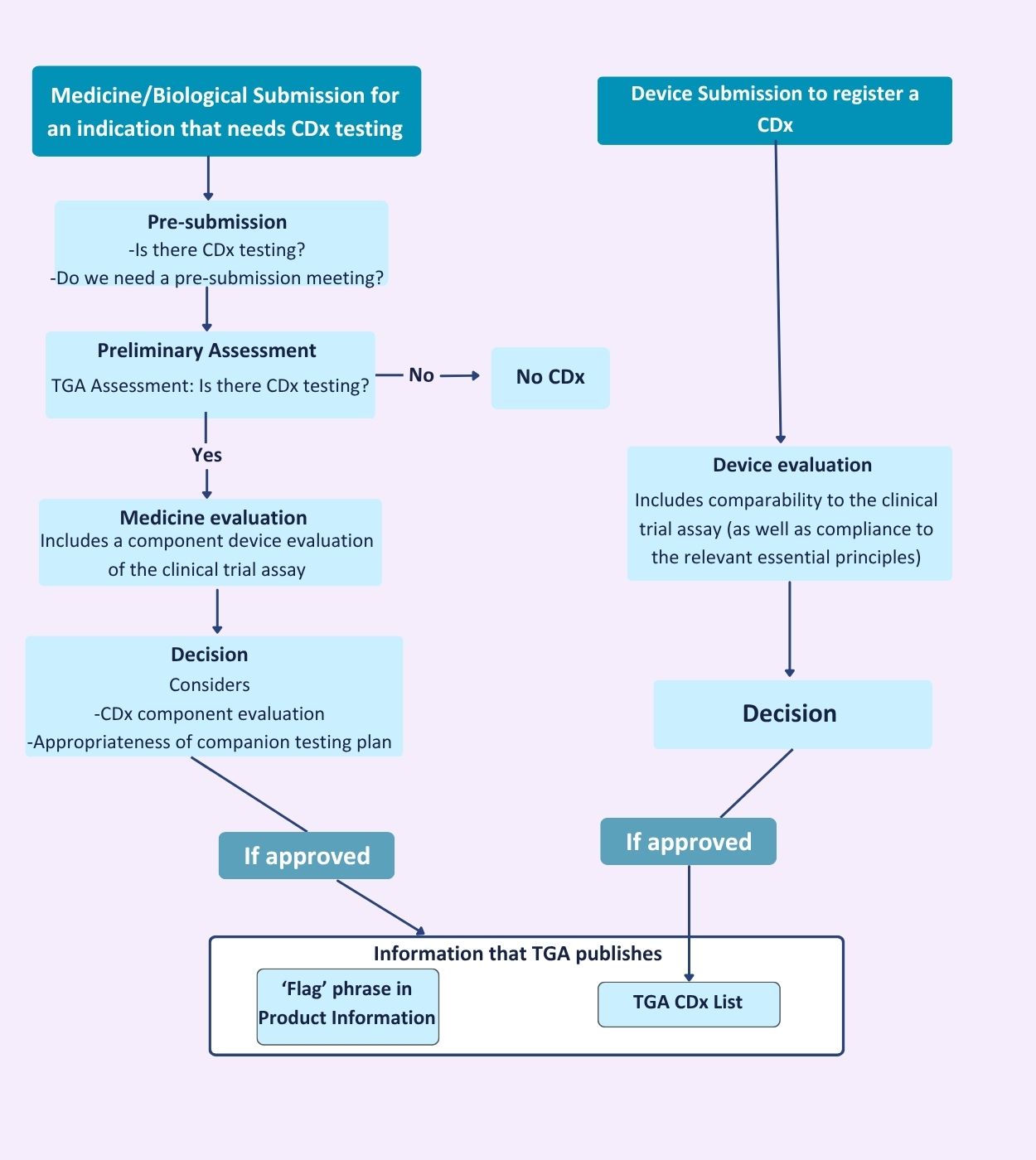A Companion Diagnostic (CDx) is an in-vitro diagnostic (IVD) medical device that plays a critical role in personalized medicine treatment by providing essential information for the safe and successful administration of a certain drug or biological. With the rapid growth and its significant contribution in patient treatments, the Therapeutic Goods Administration, TGA implemented the guidance for CDx regulatory requirements that came into effect on February 1, 2020.
What Are InVitro Companion Diagnostics(CDx)?
As per the Therapeutic Goods (Medical Devices) Regulations of 2002 of Australia, companion diagnostics are defined as follows:
- It is an IVD medical device or an in-house IVD medical device; and
- It is intended by its manufacturer to be used for the examination of a specimen from the body of an individual:
- To identify whether the individual would be likely to benefit from the use of a particular medicine or biological; or
- To identify whether an individual is likely to be at particular risk of a serious adverse reaction to the use of a particular medicine or biological; or
- To monitor the individual’s response to the use of a particular medicine or biological; and
- It is mentioned in the product information for the medicine or the instructions for use of a biological as being essential for the safe and effective use of the corresponding medicine or biological; and
- It is not intended by the manufacturer to be used for the examination of the specimen merely to determine whether the medicine or biological is compatible with the individual (where the medicine or biological comprises blood, a blood component, cells, tissue or an organ from a donor other than the individual)
Also Read: Medical Device Registration Services
In Vitro Companion Diagnostic Devices Regulations In Australia
- As per the Medical Devices Regulations 2002 of Australia, companion diagnostics are classified as class 3 IVDs posing moderate or high personal risk on use.
- Each CDx requires a separate application and should be included in the Australian Register of Therapeutic Goods (ARTG) separately with a Unique Product Identifier (UPI), and the device sponsor should indicate in the application form that the application is for CDx.
- TGA conducts a mandatory application audit to include CDx in the ARTG, unless the application is supported by TGA or one of the overseas regulators’ conformity assessments among EMA, Pre-Market Approval by USFDA, PMDA Japan, HSA Singapore or Health Canada.
- However, TGA may conduct a non-mandatory application audit for applications supported by overseas regulatory documents.
- The TGA publishes approved CDx on in the TGA CDx List. The list includes the approved CDx IVDs available for newly registered medicines or biological indications that require CDx testing.
- Sponsors may submit the CDx application concurrently with the medicine or biological for concurrent review.
- However, a CDx application for inclusion in the ARTG is only submitted if the corresponding therapeutic indication is either approved or is under concurrent review by the TGA.
Contact us For
Evaluation of Companion Diagnostic IVDs in Australia
The evaluation process for companion diagnostics in Australia is as follows:
Also Read: Top Regulatory Affairs Consultant For Medical Devices
Responsibilities of the Sponsors for Companion Diagnostics Registration in Australia
4.1 Responsibilities of device sponsors
While submitting the application, the device sponsor must include following data demonstrating compliance with the applicable conformity assessment procedures and with the relevant essential principles:
- Device history, including any international approvals, rejections or withdrawals
- Design and manufacturing information
- Instructions for use (IFU)
- Clinical performance
- Clinical utility, as applicable
- Analytical performance, including validation of any controls/calibrators/reference materials or internal standards utilised
- Risk analysis
- Stability data
- Additionally, device sponsor should ensure timely coordination with the medicine or biological sponsors for the concurrent review of the application.
4.2 Responsibilities of a medicine/biological sponsors
- At the time of submission of an application for a new indication for a medicine or biological, the sponsor should use the CDx identification guide to determine whether the indication requires CDx testing.
- If the sponsor is unsure, it is recommended consult the TGA by requesting a pre-submission meeting with the Prescription Medicines Authorisation Branch.
How to Apply for Changes to Companion Diagnostics in Australia
Here are the regulatory considerations for post-market changes to the Companion Diagnostic devices in Australia by TGA:
- To change any details of the device the sponsors of CDx included in the ARTG should apply to TGA by completing the device change request form.
- Following changes may be included in the application:
- A change in name (UPI) of the CDx
- A change to the intended purpose, for e.g., change to the target or biomarker detected, addition of other targets or biomarkers to be detected, change in cut-off concentration or decision point for receiving the medicine or biological, expanded medicine or biological indications, addition of a new type of specimen or an addition or change to the function of the software used with the device
- Change to the manufacturer name or address
Also Read: Medical Device Registration Services
Conclusion
With the pivotal role of companion diagnostics in personalized medicine and evolving regulatory requirements, it is essential to comply with current regulatory standards to ensure smooth evaluation of the products.
At Artixio, we provide strategic regulatory support for companion diagnostics and offer expert guidance to help clients to comply with global regulatory requirements and faster market access. For more details, contact us today.





